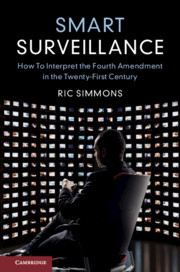Description
Smart Surveillance
How to Interpret the Fourth Amendment in the Twenty-First Century
Author: Simmons Ric
Looks at the effect of new technologies and privacy, arguing that advances in technology can enhance privacy and security at the same time.
Language: English
Subject for Smart Surveillance:
Approximative price 114.03 €
In Print (Delivery period: 14 days).
Add to cart
Smart Surveillance
Publication date: 08-2019
270 p. · 15.7x23.4 cm · Hardback
Publication date: 08-2019
270 p. · 15.7x23.4 cm · Hardback
Approximative price 39.35 €
In Print (Delivery period: 14 days).
Add to cart
Smart Surveillance
Publication date: 08-2019
270 p. · 15.2x22.7 cm · Paperback
Publication date: 08-2019
270 p. · 15.2x22.7 cm · Paperback
Description
/li>Contents
/li>Biography
/li>
Over the last decade, law enforcement agencies have engaged in increasingly intrusive surveillance methods, from location tracking on cell phones to reading metadata off of e-mails. As a result, many believe we are heading towards an omniscient surveillance state and irrevocable damage to our privacy rights. In Smart Surveillance, Ric Simmons challenges this conventional wisdom by taking a broader look at the effect of new technologies and privacy, arguing that advances in technology can enhance our privacy and our security at the same time. Rather than focusing exclusively on the rise of invasive surveillance technologies, Simmons proposes a fundamentally new method of evaluating government searches - based on quantification, transparency, and efficiency - resulting in a legal regime that can adapt as technology and society change.
Introduction: the myth of the surveillance panopticon; 1. The cost-benefit analysis theory; 2. Measuring the benefits of surveillance; 3. Quantifying criminal procedure; 4. Reactive surveillance; 5. Binary searches and the potential for 100% enforcement; 6. Public surveillance, big data, and mosaic searches; 7. The third party doctrine dilemma and the outsourcing of our Fourth Amendment rights; 8. Hyper-intrusive searches; Conclusion: implementing the change.
Ric Simmons is the Chief Justice Thomas J. Moyer Professor for the Administration of Justice and Rule of Law at the Moritz College of Law at the Ohio State University. He is the co-author of four textbooks on evidence and criminal procedure, and he has published over two dozen scholarly articles in law journals. His scholarship focuses on the Fourth Amendment and how courts and legislatures should react to the impact of new technologies in regulating surveillance.
© 2024 LAVOISIER S.A.S.

